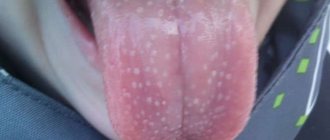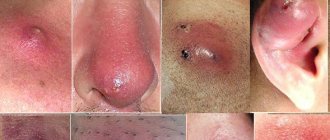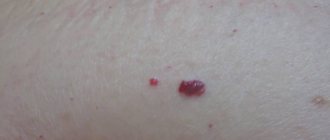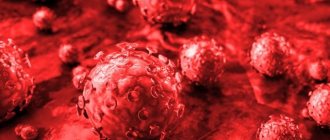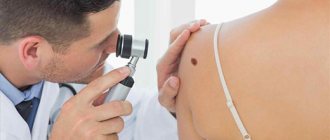A carbuncle is an acute purulent-necrotic inflammatory process involving several nearby hair follicles and sebaceous glands.
The process originates in the epidermis from multiple adjacent pustules, but quickly grows and spreads to the subcutaneous tissue with the formation of a general infiltrate. After the dead areas are removed, a deep ulcer opens, which heals with the formation of a rough scar. The pathology is treated by a dermatologist and surgeon.
Carbuncle - what is it?
Any carbuncle is an inflammation caused by an infection. Structurally, it is the result of the fusion of several boils, therefore, unlike the latter, it has a more severe manifestation.
On a note! According to statistics, pathology occurs 1.5 times more often in men than in women, and the main percentage of cases (up to 40%) occurs in the summer.
In its development, each carbuncle goes through 3 stages:
- infiltration – the formation and growth of dense nodules with the formation of a single inflamed infiltrate, which can reach a diameter of 10 cm or more;
- suppuration - maturation of the infiltrate with the formation of outlet openings emitting pus;
- necrosis and rejection - suppuration stops and the death of damaged tissue begins, followed by scarring.
A typical example of appearance is the carbuncle in the photo:
Causes
The causative agent of the inflammatory process is usually Staphylococcus aureus, often accompanied by other bacteria (Pseudomonas aeruginosa, Enterococcus, Escherichia coli, Proteus, Streptococcus). Their uncontrolled reproduction in the epidermis is caused by the following reasons:
- non-compliance with hygiene rules and unsanitary conditions at home;
- immunity disorders due to severe chronic diseases;
- metabolic pathologies – diabetes, obesity;
- anemia, vitamin deficiency, severe physical and emotional exhaustion;
- unfavorable environmental working and living conditions - frequent contact with petroleum products, exhaust gases, cement and asbestos dust;
- increased secretion of the sebaceous glands;
- skin microcracks, scratching insect bites.
Carbuncles prefer to appear in places with well-developed loose subcutaneous tissue - on the back of the neck, in the maxillofacial area, in the area between the shoulder blades, on the lower back, in the armpits, on the buttocks, and less often on the limbs.
Attention! The greatest danger is represented by purulent formations in the head area. The infection concentrated in them through the blood and lymph flow can easily penetrate the tissues of the brain and its membranes, causing severe damage to the nervous system. Self-medication of such carbuncles is strictly contraindicated!
Symptoms of carbunculosis
A skin carbuncle develops from a small nodule that quickly increases in size. External distinctive symptoms of pathology:
- local increase in temperature - the skin in the affected area is hot to the touch;
- pronounced swelling with a varnished, stretched surface;
- hyperemia with a dark (burgundy or blue) tint to the tissues;
- during suppuration, the skin of the infiltrate breaks through with the formation of small holes (“sieves”) oozing pus, which at a later stage merge into one large hole;
- unpleasant bursting pain during the growth of the tumor and sharp tugging pain - at the stage of suppuration; when moving or touching the carbuncle, irradiation to other parts of the body is possible.
The local focus of inflammation affects the entire body, dictating a general deterioration in well-being:
- increase in body temperature to 39-40 C;
- headache;
- intoxication of the body with nausea and vomiting;
- loss of appetite, loss of strength;
- increased heart rate.
With exhaustion, low body resistance, as well as in older people and in the absence of treatment, the process becomes more pronounced and leads to aggravation of symptoms with various complications - from fever to sepsis.
How to diagnose
The diagnosis of carbunculosis usually does not raise questions. The main approach used by the doctor is differential diagnosis, as well as laboratory tests to identify the pathogen.
In differential diagnosis, one should distinguish the signs of a carbuncle from the symptoms of a boil, abscess, phlegmon, anthrax, hidradenitis:
- A single boil forms only in the superficial layers of the skin, without covering the hypodermis and subcutaneous tissue. Pus does not come out through multiple openings, but through a single one. There is no pronounced effect on the entire body in the form of high temperature. The only similarity is that a carbuncle is essentially a union of several adjacent boils.
- Phlegmon is an inflammation spread throughout the tissue, without a separate center.
- An abscess can form not only in the dermis and tissue, but also in other tissues - muscle, bone, parenchymal.
- With hidradenitis, the inflammatory process does not involve the hair follicles, but the sweat glands, so the pathology manifests itself mainly in places of high concentration - in the groin, armpits, and chest.
- In carbunculosis with anthrax pathogens, there is no sensitivity at the site of the lesion, and the ulcer itself is devoid of purulent contents.
On a note! The most specific sign of a carbuncle is the dark color of the affected tissues (the origin of the name “carbuncle” is from the Latin carbunculus - ember), which allows us to draw a parallel only with the symptoms of anthrax. In all other above-mentioned cases, there is no characteristic tissue pigmentation.
In addition to an external examination with a patient interview, additional laboratory tests are carried out:
- general blood test - to assess the degree of inflammation;
- sugar test - to detect diabetes;
- blood test for sterility - to exclude the possibility of sepsis;
- bacteriological analysis of the contents of the carbuncle - to identify the causative agent of infection and determine its sensitivity to antibiotics.
Furuncle
A furuncle (in the old days called a “boil”) is a complication of staphylococcal folliculitis (purulent inflammation of the hair follicle). Not only the pilosebaceous sac, but also the surrounding tissues are involved in the inflammatory process. Acute purulent-necrotic inflammation ends with the rejection of molten (purulent) masses with the formation of scar tissue.
Rice. 2. With a boil (picture on the left), not only the pilosebaceous sac, but also the surrounding tissue is involved in the inflammatory process. With a carbuncle, the inflammatory process involves several hair follicles (picture on the right).
Treatment methods for carbuncle
Depending on the stage of the inflammatory process, the general condition of the patient and the location of the carbuncle, conservative or surgical treatment is used.
Conservative treatment
Conservative methods using drug therapy and physiotherapy are relevant for small carbuncle sizes and in the early stages of the inflammatory process, until a purulent-necrotic core has formed. Also important is the absence of severe intoxication of the body and maximum removal of formations from the head and main lymph nodes. If these conditions are not met, conservative methods are used as an accompanying measure during surgery.
Attention! With carbunculosis, early diagnosis and timely treatment are of great importance. In such cases, there is a chance to avoid surgery, and the recovery itself is much easier and takes less time.
For carbuncle, the following are most often prescribed:
- antibiotics;
- anti-inflammatory (NSAID) compounds;
- painkillers;
- detoxifiers;
- drugs to regulate cardiac activity (if necessary) and antiplatelet agents to prevent thrombophlebitis.
After opening the abscesses, topical preparations are used:
- antiseptics for wound disinfection;
- antibacterial ointments;
- proteolytic and emollient compounds against scar formation.
For more active absorption of medications, physical therapy is prescribed. They have a disinfecting effect, increase blood circulation in the affected area, thereby reducing the size of necrotic areas and accelerating the healing process.
Physiotherapy techniques:
- UHF therapy;
- UFO therapy – ultraviolet irradiation of blood;
- magnetic therapy;
- ILBI – intravenous laser irradiation of blood.
Surgery
Surgical removal of the source of inflammation is the main treatment method for severe deep carbunculosis with the formation of necrotic areas and poor discharge of purulent contents. In addition, urgent removal of the carbuncle is indicated if there is a sharp deterioration in the patient’s general health.
The operation is performed in a hospital using local or general (if necessary) anesthesia. The procedure takes no more than half an hour and takes place in 3 stages:
- The infiltrate is excised, removing necrotic areas and pus.
- The wound is thoroughly washed with antiseptic solutions and drainage is installed to drain the purulent exudate.
- The cleaned wound is treated with antibacterial compounds and healing ointments.
The first days after surgery, antibiotics and antibacterial agents are prescribed. Other medications, as well as physical therapy, are prescribed depending on the patient's condition.
On a note! If a carbuncle of the neck or facial area is diagnosed, the patient is prescribed bed rest.
ethnoscience
Homemade recipes are good as an addition to therapy prescribed by a doctor, but not as independent treatment. They help reduce the toxicity of antibiotics, enhance the effect of disinfectants, increase the body's defenses and accelerate tissue regeneration.
Simple and effective recipes:
- Grind fresh plantain leaves into a paste and apply to the affected area; keep for 0.5-1 hour, then replace with a new compress; the herb effectively draws out pus, has an anti-inflammatory and detoxifying effect;
- ointment based on dry herbs of calendula, sweet clover, St. John's wort and fat (or baby cream); 1 tbsp. l. Grind herbs of your choice or mixtures thereof in a mortar to a powder and mix with 1 tbsp. l. fat and knead thoroughly; It is recommended to constantly lubricate the surface of the carbuncle with the resulting mixture until it is completely healed;
- rinsing and dressings with sea salt effectively draw out pus, relieve inflammation, and clean the wound; in this case, you can prepare either a hypertonic solution (with a teaspoon per glass of water) or a concentrated solution (more suitable for disinfection);
- aloe leaf - fresh or mixed with honey - apply as a bandage for half an hour 2-3 times a day;
- compresses with a decoction of celandine have a pronounced antibacterial effect - the name of the herb speaks for itself;
- internal intake of infusions of antibacterial herbs: St. John's wort, chamomile, sage, sweet clover, yarrow, wormwood, calendula, nettle, thyme.
It will not be superfluous to add natural antibiotics such as natural honey, turmeric, ginger, garlic, propolis, cranberries, onions, horseradish, and pomegranate to your daily diet.
Surgical intervention
In severe forms, poor discharge of purulent discharge, and rapidly deteriorating health, the doctor will prescribe opening the abscess and removing the pus. Drainage ensures the fastest drainage of infected fluid.
After surgery you will need:
- conservative therapy;
- changing antiseptic dressings twice a day;
- taking antibiotics, restoratives;
- physiotherapeutic procedures.
Important! Take a full course of antibacterial drugs. Interrupted treatment will negate the efforts of doctors and cause bacteria to become resistant to the drug. In case of relapse, a stronger antibiotic will be required, which will harm the stomach, intestines, and immune system.
Complications of carbunculosis and its consequences
If a staphylococcal infection enters the blood and/or spreads to deeper tissues, covering adjacent organs, serious complications develop from individual systems and the entire body:
- lymphadenitis with damage to adjacent lymph nodes; in severe cases, the process develops into lymphangitis with the involvement of lymphatic vessels and can “spread” throughout the body’s lymphatic system;
- purulent meningitis - with cervicofacial localization of carbuncles, the infection with blood penetrates the blood-brain barrier, causing serious damage to the nervous system;
- extensive phlegmon - a purulent process forms diffuse purulent inflammation of the area adjacent to the carbuncle;
- phlegmons, adenophlegmons, abscesses with “spreading” of the infection and spreading to deeper layers of tissue;
- erysipelas of the skin - unlike phlegmon, does not penetrate into the deeper layers and occurs, as a rule, when affected by a streptococcal infection;
- vascular pathologies - infectious phlebitis, thrombophlebitis, as well as vascular bleeding with weakening of the vascular wall;
- osteomyelitis – when infection spreads to bone tissue;
- sepsis is a general blood infection with a high risk of death.
Complications are a typical phenomenon in the absence of timely treatment, with serious pathologies of the immune system and some chronic diseases, such as diabetes.
Clinical picture of a boil
Boils develop on those areas of the skin where hair grows - on the face, neck (back surface), forearms, thighs, lower back and buttocks.
A boil on the face, nose, head and upper lip is the most dangerous location. Thrombophlebitis of the facial veins, the development of purulent meningitis and septicemia are serious complications of the disease.
The general condition of the patient remains satisfactory with single boils. Furunculosis and multiple boils are often accompanied by fever, malaise and headache. In severe cases, lymphangitis and lymphadenitis develop (enlargement of regional lymph nodes).
Rice. 5. The photo shows a boil on the eyelids.
Rice. 6. The photo shows a boil on the neck and leg.
Preventive measures
Particularly relevant when carbuncles appear repeatedly. In this case, it is imperative to take measures aimed at increasing the level of hygiene and strengthening the immune system.
Basic recommendations:
- Keep your body clean with water treatments - showers, wet wipes, baths; You can add infusions of medicinal herbs to the water - chamomile, calendula, sage, string, violet. Use only personal hygiene products!
- Enrich your diet with fresh vegetables and fruits, as well as mineral supplements and vitamins. This will help strengthen the immune system and increase the body's resistance to infections.
- Avoid prolonged overwork, stress, and nervous experiences. Alternate work with proper rest.
- Avoid tight “synthetics” in clothes. Fabrics should “breathe” allowing air to circulate freely.
- For insect bites and abrasions, treat the skin with antiseptics.
- Treat any infectious diseases, even common colds, in a timely manner. Do not be lazy to undergo therapy until complete recovery.
Remember, it is a neglectful attitude towards yourself and your health that causes diseases that in fact can be easily avoided.
Prevention
Preventive measures that are aimed at preventing the appearance of a boil (carbuncle) should include a correct, healthy lifestyle. In addition to physical education and sports, follow simple rules:
- Follow the rules of personal hygiene.
- Take care of your skin if you sweat excessively. Use products containing farnesol - soap (“UtraA-C”, “Faith in nature”), antiperspirant (Rexona, Lady Speed Stick cream), deodorant (“Nivea”, “Dove”).
- If the skin is damaged, treat it with antiseptic agents (70% alcohol, brilliant green, iodine).
- Play sports, take a walk in the fresh air in the evenings.
- Strengthen your immune system. Eat more fresh vitamins (vegetables, fruits, greens).
